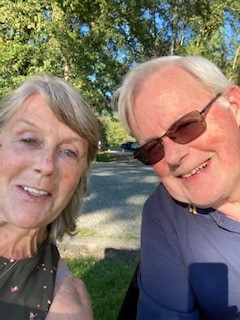 As a high school vice principal for many years, and later a community coroner, Art Erasmus was used to tackling challenging occupations with enthusiasm and practical thinking before he retired. He was always involved in a project or two in his spare time and, even in retirement, he and his spouse Lesley were active with the local Rotary Club, fundraising and supporting aid projects in Africa and around their local Terrace, BC community.
As a high school vice principal for many years, and later a community coroner, Art Erasmus was used to tackling challenging occupations with enthusiasm and practical thinking before he retired. He was always involved in a project or two in his spare time and, even in retirement, he and his spouse Lesley were active with the local Rotary Club, fundraising and supporting aid projects in Africa and around their local Terrace, BC community.
All of that came to an abrupt halt in 2015, when Art was out using a snowblower to clear his driveway and suffered a stroke. One that, while hard to diagnose immediately, would have long-lasting effects on his ability to function and irreversibly change the trajectory of his retirement years.
___________________
 Angela Wright was living life to the fullest in her late 30s, as she enjoyed the work and lifestyle of being a bright, successful investment management professional. From running the New York Marathon to getting outdoors and exploring the world through travel, she felt she was in excellent physical shape and had recently received a clean bill of health during a full physical exam from her physician.
Angela Wright was living life to the fullest in her late 30s, as she enjoyed the work and lifestyle of being a bright, successful investment management professional. From running the New York Marathon to getting outdoors and exploring the world through travel, she felt she was in excellent physical shape and had recently received a clean bill of health during a full physical exam from her physician.
Despite all of this, while on a fishing trip with a business client just outside of Smithers, BC in 2011, she woke up one morning, unsure of what was wrong while suffering from a splitting headache. As the day wore on and the headache worsened she didn't think her problems could be anything beyond a simple, albeit painful headache.
After eventually giving in and allowing her colleagues to take her to the Smithers hospital, Angela wound up on an air ambulance to Vancouver General Hospital where she was unconscious by the time she arrived. The surprising diagnosis for this young, active woman? A stroke: one that would also change the plans and dreams she had for her future.
Despite coming from different backgrounds and age demographics, Art and Angela share a number of things in common, both having experienced the many highs and lows that go along with recovery from, and living with, a stroke.
But while the acute care phase of a person's stroke journey is challenging and the rehabilitation phase of that person's life can feel overwhelming and uncertain at times, for both people it's day-to-day living after having a stroke that can seem the hardest part of it all.
"It's hard to communicate when your brain isn't working properly," says Art. "There are large gaps missing for me," he explains. "I used to have a practically flawless memory."
One thing Art is clear about is that he feels lucky to have experienced a stroke later in life.
"I was past the end of my career, so it kind of happened at a good time," he says. "All of a sudden, your life is totally different and you can't do things you've done for your whole life." Art also describes how his cognitive abilities have been dramatically affected, making it impossible for him to understand concepts and topics that he used to master with ease.
Art's spouse Lesley, agrees that the challenges of everyday living are multiplied for not only the person who had the stroke but also for any caregivers that person is lucky enough to have in their life.
"I've had to learn a lot of patience," she says. "And I've also gone out of my way to learn as much about strokes and recovery care as I can."
"When stroke hits, it's not like a disease you can plan for. The changes are immediate and you have to turn around 180 degrees and do something else."
Now only in her late-40s, Angela's sense of loss and frustration is more pronounced. Frustrated by a lack of career opportunity available to her since her stroke, she's made a good recovery in so many ways, especially because of how far her physical function has come from the days early on when she was bilaterally paralyzed and physically unable to even hold a cup of tea.
She spent almost two months in recovery at VGH and then another two months at GF Strong before being able to return to her home. It was only after she arrived back there that she fully realized how difficult returning to "a normal life" was going to be.
"Living alone in downtown Vancouver, I thought 'I'm going to rock this' until I found out how hard it was making simple decisions after living in health care facilities for the previous four months."
"With injuries like tissue damage on my nerves and spinal column I was afraid to walk back and forth to the grocery store which is only three blocks away." She recalls the first moment she began to feel "normal" was when she stepped off the curb to walk across the street and didn't have to worry about feeling like she would fall. A small step for so many of us but a huge step for Angela at that time.
Fast forward to today and, after thousands of hours spent on recovery, much of her ability to function has thankfully returned.
"People look at me now and say, 'How are you this person?' when they read my patient chart," she says. "But it's been a really long, hard road to get here. You can't control everything but if you work at the things you can control, you can do a lot of good things."
Despite both Art and Angela making a good recovery from their respective strokes, both of them face significant challenges daily as they learn to live with stroke. For Art, he's lost years of memories and the ability to do challenging cognitive functions. For Angela, her inability to use her left hand and a number of chronic pain issues still plague her.
It's these long-term ongoing challenges that many care providers in the health system find hard to understand and support stroke survivors through.
For Angela, the importance of investing money to help people live after surviving a stroke is paramount.
"We need to have the right toolkit to support people in their daily lives," she says. "And that toolkit needs to be customized for each person."
To help people through the long recovery times and home-related adjustments that often accompany a stroke a number of resources have been developed including:
To help potential stroke victims and their families recognize when a stroke might be occurring, the Heart & Stroke Foundation of Canada has their FAST campaign that includes an easy reminder of when to call for help:
- Face: Is it drooping?
- Arms: Can you raise both over your head?
- Speech: Is it slurred or jumbled?
- Time: Call 911, right away!
If you or someone around you experiences any of these signs, call 9-1-1 immediately. Do not drive to the hospital; an ambulance will get you to the best hospital for stroke care. Quick treatment helps limit damage and increases chance of full recovery. One-third of stroke patients in Canada wait too long for help and with stroke, brain damage begins in minutes.
Art, Lesley, and Angela have all shared their experiences and learnings throughout different initiatives led by Stroke Services BC (SSBC) in order to advance improvements in care and highlight the direct experience of people with stroke and their caregivers. SSBC would like to take this opportunity to thank all of them for their openness and commitment to advancing care in this province.
